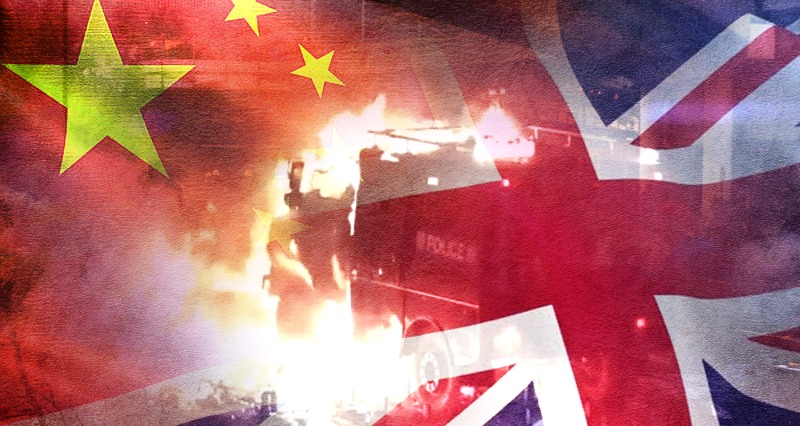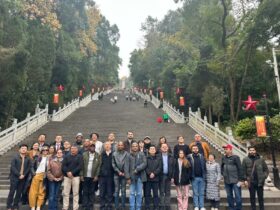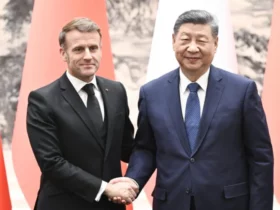A change of tactics
The protests in Hong Kong have long since spilled over from peaceful channels into violent clashes between participants and the police. This time the battlefield has moved to the universities. On five campuses in China, students turned their universities into insurgent fortresses. The ensuing conflicts resembled medieval battles interspersed with the madness of Mad Max aesthetics: bows and arrows, fire catapults and rocks against the background of burning cars and bridges…
The focus of the weekend was on the Polytechnic University, where young people built barricades and walls of bricks and cement, built weapons and began to produce Molotov cocktails. Some people tried to slip past the police cordons, either through the sewers or by descending the rope hanging from the bridge. The police conducted a virtual siege of the building.
The move marked a significant tactical shift for the protesters, whose motto has been “be like water”, a philosophy about being flexible that has underpinned the leaderless wildcat protests.
On the other side of the barricades and beyond the burning debris there were special forces lines armed with batons, tear gas and rubber bullets.
There were violent clashes between the police and anti-government demonstrators – protesters threw Molotov cocktails at the police, set fire to the campus and fired arrows from bows, while law enforcement in turn used tear gas, water cannons and ink blasts before making mass arrests. Hong Kong law enforcement officials detained at least 400 protesters in the area.
What are the young people protesting against?
After Hong Kong rejected the idea for the extradition bill that triggered the first protests, protesters have been unable to articulate their ideas clearly. They are going out to protest for its own sake, pushing vague demands for “freedoms”, “an end to police violence”, etc. There is almost no specifics – the students simply take to the streets and start to organize riots with arson and gunfire.
The riots have hurt Hong Kong’s tourism, trade and transport sectors. The main roads in the center are blocked.
Whereas in the past there were clear democratic calls in the protesters’ camp, now the only goal of the remaining radicals on the street is to inflict maximum damage on the police.
For example, in the case of the Polytechnic University, the protesters themselves set fire to the entrance to the building, as well as the bridge connecting the campus to the nearest subway station.
Carrie Lam, Hong Kong’s chief executive officer, said about 600 protesters surrendered to the authorities overnight on Polytechnic University campus. Many of those on campus were unwittingly held hostage.
In an effort to keep the police out, protesters barricaded one of the tunnels leading to the university, threw Molotov cocktails and for the first time in their protests wounded a police officer with an arrow.
After these events Carrie Lam she was shocked that campuses had transformed into “weapons factories”.
Ban on masks and human rights bill. Failure of the two-system structure
While the police tried to storm the university campus, the Hong Kong High Court of Justice gathered to hear a suit from 25 opposition lawmakers. It ruled that the city administration’s decision in early October to ban masks during mass gatherings did not comply with the Basic Law of the Special District. Over the past month and a half, more than two hundred people have been arrested in Hong Kong for violating the ban, while since June over 4.5 thousand people have been behind bars. However, despite the arrests, the violations continued – the demonstrators were not brave enough to face the cameras.
However, on Monday, an unexpected decision by a Hong Kong court lifted a month-long ban on wearing a mask, imposed by the government in the hope of stopping the ongoing political unrest in the city.
Naturally, the decision aroused anger in China. The Hong Kong government said the controversial ban would no longer be enforced while it considered appealing, but Chinese powers said this regional courts have no power to rule on the constitutionality of legislation under the city’s Basic Law.
It is important to note that the lower courts cannot rule on constitutional issues.
Although the principle of “One country, two systems” officially remains in force, it is beginning to snap at the seams as the protests continue flare up, particularly from a legal point of view. Western media are actively covering this issue, focusing on the weakening of China’s center of power in the face of protests. Also, US Senate backed Hong Kong “human rights bill”, what made China angry (Americans can introduce sanctions against officials deemed “responsible for human rights violations in Hong Kong”). All of this indicates foreign interference in Chinese affairs.
Experts say that the protests may in practice spoil legitimate processes, such as the November 24 elections.
The protests that have been going on since June are also hurting Hong Kong in general, according to some estimates. The district’s economy has entered into a technical recession for the first time in many years, which threatens to continue throughout 2020. Hong Kong authorities have sharply worsened the forecast of GDP dynamics for 2019 due to the ongoing mass protests: according to the new forecast, the district’s economy will decline by 1.3% this year – it will be the first recession since 2009.
The violent unrest of the past few months has affected the number of tourists visiting Hong Kong, led to a significant decline in consumer demand and worsened investor sentiment.
Hong Kong’s economy is adversely affected by the trade war between the US and PRC. In the worst case scenario, it could be European and US sanctions, which would be completely disadvantageous to China. In many ways, this is why Beijing is trying to keep the balance in these protests so as not to provoke a major international scandal.
There are no clear demands
As we noted earlier, the protesters do make any clear demands at their rallies. They said they were disappointed that nothing had changed since the 2014 umbrella revolution, when protesters occupied the city streets for 11 weeks, and the erosion of freedoms in the city followed.
Most stated that their tactics were justified by the “brutality of the police” to suppress the protests.
There is ample evidence that protests in Hong Kong are supported from abroad by forces that simply use anti-Chinese educated migrant youth.
The goal of Western forces is to weaken the power of growing China. Since it is becoming almost impossible to compete with it economically, the only way out of this is another colored revolution, this time in Asia.
How long will the protests last? It’s hard to say. Even if the current escalation subsides under the control of the police, new protests could easily reappear. Now the protesters, having achieved their goal (the abolition of the law on extradition), are protesting without a specific goal, simply saying they are “against police violence”… in the long run, however, it is clear that those organizing the protests would like to see legal, economic, political and even military separation of Hong Kong from mainland China.

















Leave a Reply